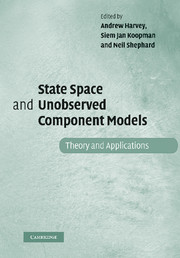Book contents
- Frontmatter
- Contents
- Preface
- Acknowledgements
- Part I State space models
- Part II Testing
- Part III Bayesian inference and bootstrap
- 7 Efficient Bayesian parameter estimation
- 8 Empirical Bayesian inference in a nonparametric regression model
- 9 Resampling in state space models
- Part IV Applications
- References
- Author index
- Subject index
9 - Resampling in state space models
Published online by Cambridge University Press: 06 January 2010
- Frontmatter
- Contents
- Preface
- Acknowledgements
- Part I State space models
- Part II Testing
- Part III Bayesian inference and bootstrap
- 7 Efficient Bayesian parameter estimation
- 8 Empirical Bayesian inference in a nonparametric regression model
- 9 Resampling in state space models
- Part IV Applications
- References
- Author index
- Subject index
Summary
Abstract
Resampling the innovations sequence of state space models has proved to be a useful tool in many respects. For example, while under general conditions, the Gaussian MLEs of the parameters of a state space model are asymptotically normal, several researchers have found that samples must be fairly large before asymptotic results are applicable. Moreover, problems occur if any of the parameters are near the boundary of the parameter space. In such situations, the bootstrap applied to the innovation sequence can provide an accurate assessment of the sampling distributions of the parameter estimates. We have also found that a resampling procedure can provide insight into the validity of the model. In addition, the bootstrap can be used to evaluate conditional forecast errors of state space models. The key to this method is the derivation of a reverse-time innovations form of the state space model for generating conditional data sets. We will provide some theoretical insight into our procedures that shows why resampling works in these situations, and we provide simulations and data examples that demonstrate our claims.
Introduction
A very general model that seems to subsume a whole class of special cases of interest is the state space model or the dynamic linear model, which was introduced in Kalman (1960) and Kalman and Bucy (1961). Although the model was originally developed as a method primarily for use in aerospace-related research, it has been applied to modelling data from such diverse fields as economics (e.g. Harrison and Stevens (1976), Harvey and Pierse (1984), Harvey and Todd (1983), Kitagawa and Gersch (1984), Shumway and Stoffer (1982)), medicine (e.g. Jones (1984)) and molecular biology (e.g. Stultz, White and Smith (1993)).
- Type
- Chapter
- Information
- State Space and Unobserved Component ModelsTheory and Applications, pp. 171 - 202Publisher: Cambridge University PressPrint publication year: 2004
- 9
- Cited by



